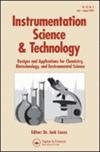广角x射线散射电弧探测器(WAXS)标定及误差分析
IF 1.3
4区 工程技术
Q4 CHEMISTRY, ANALYTICAL
引用次数: 0
摘要
摘要在广角x射线散射(WAXS)实验中,利用一维电弧探测器可以有效地扩大采集到的衍射或散射信号的角度范围。在实际应用中,圆弧探测器中心、样品中心和光束光斑之间的相对位置可能会重叠或不对齐。因此,有必要对电弧检测仪的仪器参数和检测角度进行校准。校准通常由标准样品进行。本文建立了基于三个标准衍射峰的角度标定和误差评定方程,并进行了相应的仿真和实验验证了标定的可行性。结果表明,三个标准衍射峰分布在探测器上的覆盖范围越大,色散越均匀,标定误差越小。感谢吴中华、陈中军、石展、邢学清、姚磊、王浩对广角x射线散射(WAXS)实验的帮助。披露声明作者无利益冲突报告。基金资助:国家重点研发计划项目[批准号2017YFA0403000],国家自然科学基金项目[批准号U1910206, 22278295, 22378291和U1910201],山西省重点研发项目[批准号202102090301002],煤炭高效低碳利用国家重点实验室[批准号J23-24-612]。本文章由计算机程序翻译,如有差异,请以英文原文为准。
Calibration and error analysis of an arc detector for wide-angle X-ray scattering (WAXS)
AbstractIn wide-angle X-ray scattering (WAXS) experiments, the use of a one-dimensional arc detector can effectively expand the angle range of collected diffraction or scattering signals. In practice, the relative positions between the centers of arc detector, sample and beam spot may overlap or misalign. Therefore, it is necessary to calibrate the instrument parameters and detection angle of the arc detector. The calibration is routinely performed by standard samples. In this contribution, the equations for angle calibration and error evaluation are constructed based on three standard diffraction peaks, and the corresponding simulation and experiment are performed to verify the feasibility of the calibration. The results indicate that the larger the coverage and the more uniform the dispersion of the three standard diffraction peaks distributed on the detector, the smaller the calibration error.Keywords: Wide-angle X-ray scattering (WAXS)one-dimensional arc detectorangle calibration AcknowledgementThe authors thank Zhonghua Wu, Zhongjun Chen, Zhan Shi, Xueqing Xing, Lei Yao and Hao Wang for their help with the WAXS experiments.Disclosure statementNo conflicts of interest are reported by the authors.Additional informationFundingThis work was supported by the National Key R & D Program of China [grant number 2017YFA0403000], the National Natural Science Foundation of China [grants number U1910206, 22278295, 22378291 and U1910201] and the Key R & D projects in Shanxi Province [grant number 202102090301002], and the National Key Laboratory of High Efficiency and Low Carbon Utilization of Coal [grants number J23-24-612].
求助全文
通过发布文献求助,成功后即可免费获取论文全文。
去求助
来源期刊

Instrumentation Science & Technology
工程技术-分析化学
CiteScore
3.50
自引率
0.00%
发文量
45
审稿时长
>12 weeks
期刊介绍:
Instrumentation Science & Technology is an internationally acclaimed forum for fast publication of critical, peer reviewed manuscripts dealing with innovative instrument design and applications in chemistry, physics biotechnology and environmental science. Particular attention is given to state-of-the-art developments and their rapid communication to the scientific community.
Emphasis is on modern instrumental concepts, though not exclusively, including detectors, sensors, data acquisition and processing, instrument control, chromatography, electrochemistry, spectroscopy of all types, electrophoresis, radiometry, relaxation methods, thermal analysis, physical property measurements, surface physics, membrane technology, microcomputer design, chip-based processes, and more.
Readership includes everyone who uses instrumental techniques to conduct their research and development. They are chemists (organic, inorganic, physical, analytical, nuclear, quality control) biochemists, biotechnologists, engineers, and physicists in all of the instrumental disciplines mentioned above, in both the laboratory and chemical production environments. The journal is an important resource of instrument design and applications data.
 求助内容:
求助内容: 应助结果提醒方式:
应助结果提醒方式:


